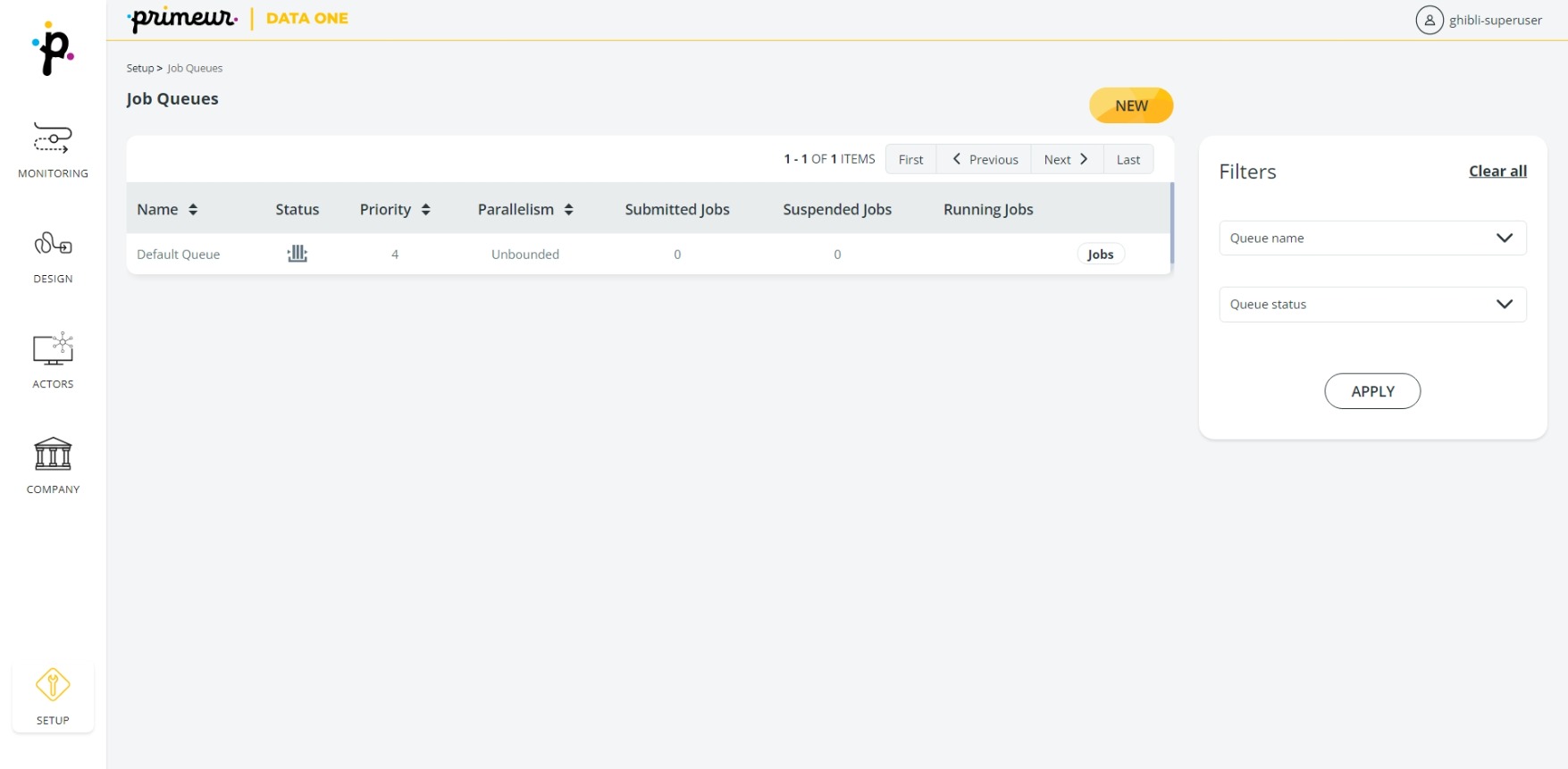Managing Job Queues
The Job Queues panel is shown in the following figure.

At the top of the panel, a bar shows the number of queues displayed out of the total number of queues existing. If more than 25 queues exist, these will be displayed on multiple pages that can be navigated selecting the options available at the top of the window. The First, Previous, Next and Last buttons will drive you to the relevant page.
Note that the number of queues displayed on each page is set to 25 and is not configurable.
To create a new queue, follow these steps:
-
Click the New button at the top of the page. The New queue window will appear.
-
In the New queue window, assign a unique name to the queue.
-
Define the status of the queue:
a. Enabled: the jobs in the queue will be worked according to the priority and parallelism settings that you will define later.
b. Scheduled: the queue will be enabled only during scheduled time slots of the current day. Outside the specified time, the queue will be disabled. You can enter the time slot in the fields appearing when checking the Scheduled radio button. Multiple time-slots can be specified in the day. E.g. [8:00-11:00], [14:30-15:30], etc. simply clicking the Add time slot button.
c. Disabled: the queue exists but jobs scheduling is suspended. -
Define the Priority: this is the Priority that will be assigned to the jobs in the queue you are creating. Priority goes from 1 (very low priority) to 10 (very high priority). This field accepts only numbers.
Jobs belonging to a queue having priority 3 will be executed before jobs belonging to a queue with priority 2. When two or more queues have the same Priority, their jobs are executed according to a global FIFO order: jobs having lower ID are executed before jobs having higher IDs. E.g.: having job 245 and job 246 both with priority 3, job 245 is executed before job 246. -
Define the Parallelism: this is the number of jobs that are executed concurrently on each CEMAN. This field accepts numbers: 0 means that no jobs are executed, 1 means that the job execution is serialized (a new job starts after the current job has completed), 10 means that 10 jobs will be executed for the queue, and so on. You can also define unlimited parallelism activating the UNBOUNDED toggle switch – this action disables the Parallelism field.

Hint!
Administrators can configure the maximum number of jobs executed in parallel going to Setup → Advanced settings → job-manager → config → job.maxCemanParallelism and editing the property entering the number of parallel jobs in the PROPERTY VALUE field. The default is 50. This value is a multiplier: at runtime, the effective number will be Active_Ceman_Nodes * job.maxCemanParallelism.
- When done, click Save to create your queue.
In the result list, queues are organized in rows and columns.

Columns are self-explaining apart from the 3 on the right that deserve a brief explanation:
- The
 chip can be clicked to jump directly to the Jobs section and check the jobs belonging to the queue.
chip can be clicked to jump directly to the Jobs section and check the jobs belonging to the queue. - The Status column shows the status of the queue with icons
 enabled,
enabled,  disabled,
disabled,
 scheduled. Hovering the mouse over the icon, a tooltip will appear.
scheduled. Hovering the mouse over the icon, a tooltip will appear. - The 3-dots icon shows the Edit and Delete options. Note that:
- The queue Name cannot be edited.
- A queue cannot be deleted if it has jobs still to be scheduled and it is associated with a Contract.
On the right-hand side of the screen, the Filters panel can be used to run queries by Queue Name or Status.
The Queue name drop-down list proposes already created Queues. The Queue status contains the ENABLED and DISABLED options – Scheduled queues fall into ENABLED.
Contracts must be associated with a queue. The Execution Queue box is available when creating or editing a Contract. By default, Contracts are associated with the Default queue. See the Creating a Contract section for details.
A job must belong to one and only one queue.
Updated 10 months ago
